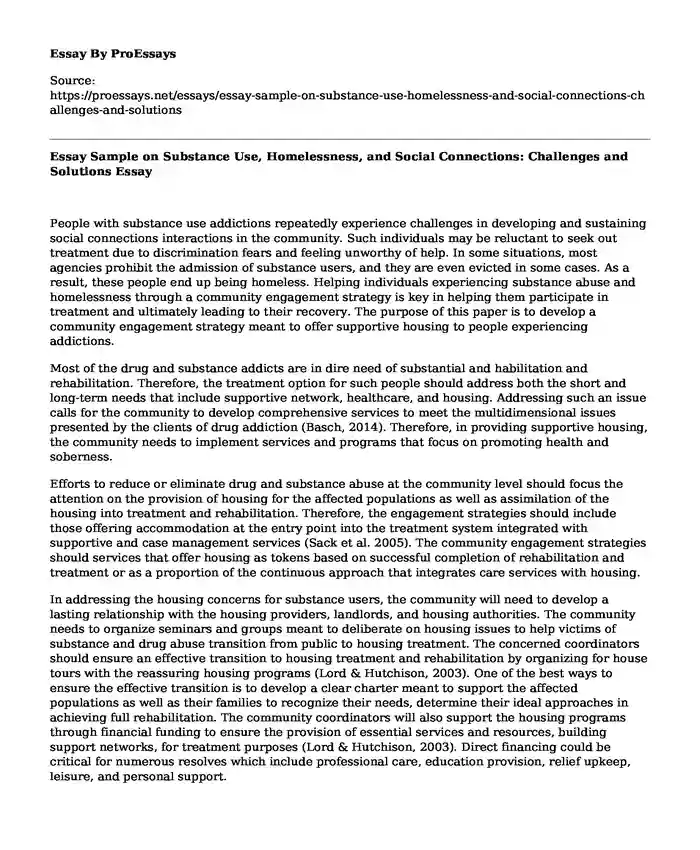People with substance use addictions repeatedly experience challenges in developing and sustaining social connections interactions in the community. Such individuals may be reluctant to seek out treatment due to discrimination fears and feeling unworthy of help. In some situations, most agencies prohibit the admission of substance users, and they are even evicted in some cases. As a result, these people end up being homeless. Helping individuals experiencing substance abuse and homelessness through a community engagement strategy is key in helping them participate in treatment and ultimately leading to their recovery. The purpose of this paper is to develop a community engagement strategy meant to offer supportive housing to people experiencing addictions.
Most of the drug and substance addicts are in dire need of substantial and habilitation and rehabilitation. Therefore, the treatment option for such people should address both the short and long-term needs that include supportive network, healthcare, and housing. Addressing such an issue calls for the community to develop comprehensive services to meet the multidimensional issues presented by the clients of drug addiction (Basch, 2014). Therefore, in providing supportive housing, the community needs to implement services and programs that focus on promoting health and soberness.
Efforts to reduce or eliminate drug and substance abuse at the community level should focus the attention on the provision of housing for the affected populations as well as assimilation of the housing into treatment and rehabilitation. Therefore, the engagement strategies should include those offering accommodation at the entry point into the treatment system integrated with supportive and case management services (Sack et al. 2005). The community engagement strategies should services that offer housing as tokens based on successful completion of rehabilitation and treatment or as a proportion of the continuous approach that integrates care services with housing.
In addressing the housing concerns for substance users, the community will need to develop a lasting relationship with the housing providers, landlords, and housing authorities. The community needs to organize seminars and groups meant to deliberate on housing issues to help victims of substance and drug abuse transition from public to housing treatment. The concerned coordinators should ensure an effective transition to housing treatment and rehabilitation by organizing for house tours with the reassuring housing programs (Lord & Hutchison, 2003). One of the best ways to ensure the effective transition is to develop a clear charter meant to support the affected populations as well as their families to recognize their needs, determine their ideal approaches in achieving full rehabilitation. The community coordinators will also support the housing programs through financial funding to ensure the provision of essential services and resources, building support networks, for treatment purposes (Lord & Hutchison, 2003). Direct financing could be critical for numerous resolves which include professional care, education provision, relief upkeep, leisure, and personal support.
The housing for substance users should be characterized by drug-free living conditions and should involve addiction recovery and peer support aids. The shelter could be classified into four levels based on the recovery needs of the affected people. According to SAMHSA (2019), “these levels range from peer-run establishments like Oxford Housing (level I) to monitored sober living homes (level II), to supervised housing (level III), and residential treatment housing (level IV).” Irrespective of housing level, the community housing should focus on maintaining the safety of client tenants while also ensuring the safety of other tenants. Alternatively, the program should promote the acceptance of clients by the broader community and the other tenants after treatment to prevent a relapse.
Conclusion
Social inclusion in addiction recovery ensures that victims can re-engage with society and develop positive connections. Through housing recovery, affected populations can offer peer support for better rehabilitation as it instills a sense of belonging for both the service providers and those that need help. Moreover, this type of community engagement ensures lower rates of incarceration and substance use once complete.
References
Basch, C. H. (2014). Poverty, health, and social justice: the importance of public health approaches. International Journal of Health Promotion and Education, 52(4), 181-187.
Lord, J., & Hutchison, P. (2003). Individualized support and funding: building blocks for capacity building and inclusion. Disability & Society, 18(1), 71-86.
Sacks, S., Ries, R. K., Ziedonis, D. M., & Center for Substance Abuse Treatment. (2005). Substance abuse treatment for persons with co-occurring disorders.
Substance Abuse and Mental Health Services Administration. "Affording Housing Models and Recovery." SAMHSA, 2 Aug. 2019, www.samhsa.gov/homelessness-programs-resources/hpr-resources/affording-housing-models-recovery.
Cite this page
Essay Sample on Substance Use, Homelessness, and Social Connections: Challenges and Solutions. (2023, Sep 15). Retrieved from https://proessays.net/essays/essay-sample-on-substance-use-homelessness-and-social-connections-challenges-and-solutions
If you are the original author of this essay and no longer wish to have it published on the ProEssays website, please click below to request its removal:
- Essay Sample on Greek Health Beliefs
- Effects of Performance Enhancing Drugs - Essay Sample
- Essay on Modern Healthcare Informatics: Leveraging ICT for Quality Care
- Research Paper on Euthanasia: An Ethical Issue that Divides Societies
- Paper Example on Distracted Driving: Teens Increasingly Involved in Accidents and Fatalities
- Essay Example on Non-Western Healing Systems: A Comprehensive Overview
- Essay Sample on Alcohol Liver Disease: The Difficulty of Obtaining a Liver Transplant







